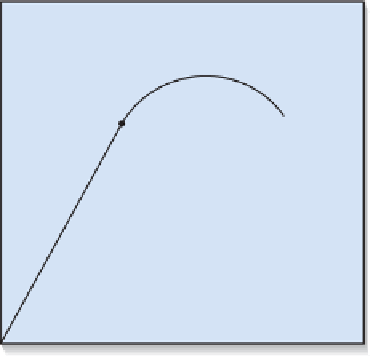Geology Reference
In-Depth Information
?
Many rocks show the effects of plastic deformation that
must have taken place deep within the crust. At or near the
surface, rocks commonly behave like brittle solids and frac-
ture, but at depth, they more often yield by plastic deforma-
tion; they become more ductile with increasing pressure and
temperature. Most earthquake foci are at depths of less than
30 km, indicating that deformation by fracturing becomes
increasingly diffi cult with depth and no fracturing is known
deeper than about 700 km.
What Would You Do
The types of stresses, as well as elastic versus plastic strain,
might seem rather esoteric, but perhaps understanding these
concepts has some practical applications. What relevance
do you think knowing about stress and strain has to some
professions, other than geology, and what professions might
these be? Can you think of stresses and strain that we
contend with in our daily lives? As an example, what happens
when a car smashes into a tree?
OF DEFORMED ROCK LAYERS
During the 1660s, Nicholas Steno, a Danish anatomist, pro-
posed several principles essential for deciphering Earth his-
tory from the record preserved in rocks. One is the
principle
of original horizontality
, meaning that sediments accumulate
in horizontal or nearly horizontal layers. Thus, if we observe
steeply inclined sedimentary rocks, we are justifi ed in infer-
ring that they were deposited nearly horizontally, lithified,
and then tilted into their present position (
plastic strain
as when they yield by folding, or they behave
like brittle solids and
fracture
(
◗
Figure 10.4). In either fold-
ing or fracturing, the strain is permanent; that is, the rocks
do not recover their original shape or volume even if the
stress is removed.
Whether strain is elastic, plastic, or fracture depends
on the kind of stress applied, pressure and temperature,
rock type, and the length of time rocks are subjected to
stress. A small stress applied over a long period, as on
a mantelpiece supported only at its ends, will cause the
rock to sag; that is, the rock deforms plastically (Fig-
ure 10.4). By contrast, a large stress applied rapidly to
the same object, as when struck by a hammer, results in
fracture. Rock type is important because not all rocks
have the same internal strength and thus respond to
stress differently. Some rocks are
ductile
, whereas oth-
ers are
brittle
, depending on the amount of plastic strain
they exhibit. Brittle rocks show little or no plastic strain
before they fracture, but ductile rocks exhibit a great deal
(Figure 10.4).
Figure 10.5a).
Rock layers deformed by folding, faulting, or both are no lon-
ger in their original position, so geologists use
strike
and
dip
to
describe their orientation with respect to a horizontal plane.
By defi nition,
strike
is the direction of a line formed by
the intersection of a horizontal plane and an inclined plane.
The surfaces of the rock layers in Figure 10.5b are good
examples of inclined planes, whereas the water surface is a
horizontal plane. The direction of the line formed at the in-
tersection of these planes is the strike of the rock layers. The
strike line's orientation is determined by using a compass to
measure its angle with respect to north.
Dip
is a measure of
an inclined plane's deviation from horizontal, so it must be
measured at right angles to strike direction (Figure 10.5b).
Geologic maps showing the age, aerial distribution,
and geologic structures of rocks in an area use a special
symbol to indicate strike and dip. A long line oriented in
the appropriate direction indicates strike, and a short line
perpendicular to the strike line shows the direction of dip
(Figure 10.5b). Adjacent to the strike and dip symbol is a
number corresponding to the dip angle. The usefulness of
strike and dip symbols will become apparent in the sections
on folds and faults.
◗
e
Fracture
Fracture
A
B
STRUCTURES
Remember that deformation and its synonym strain refer
to changes in the shape or volume of rocks. During defor-
mation, rocks might be crumpled into folds, or they might
be fractured, or perhaps folded and fractured. Any of these
features resulting from deformation is referred to as a
geo-
logic structure
. Geologic structures are present almost
everywhere that rock exposures can be observed, and many
are detected far below the surface by drilling and several
geophysical techniques.
Increasing strain
◗
Figure 10.4
Rock Response to Stress Rocks initially respond to
stress by elastic deformation and then return to their original shape
when the stress is released. If the elastic limit is exceeded, as in
curve A, rocks deform plastically, which is permanent deformation.
The amount of plastic deformation rocks exhibit before fracturing
depends on their ductility. If they are ductile, they show considerable
plastic deformation (curve A), but if they are brittle, they show little
or no plastic deformation before failing by fracture (curve B).











Search WWH ::

Custom Search